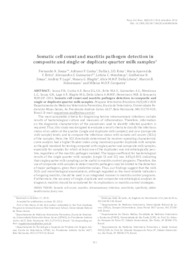Somatic cell count and mastitis pathogen detection in composite and single or duplicate quarter milk samples.
Somatic cell count and mastitis pathogen detection in composite and single or duplicate quarter milk samples.
Author(s): SOUZA, F. N.; CUNHA, A. F.; ROSA, D. L. S. O.; BRITO, M. A. V. P. e; GUIMARAES, A. S.; MENDONCA, L. C.; SOUZA, G. N. de; LAGE, A. P.; BLAGITZ, M. G.; LIBERA, A. M. M. P. D.; HEINEMANN, M. B.; CERQUEIRA, M. M. O. P.
Summary: Abstract The most acceptable criteria for diagnosing bovine intramammary infections include results of bacteriological culture and measures of inflammation. Therefore, information on the diagnostic characteristics of the procedures used to identify infected quarters is required. Thus, this study was designed to evaluate a set of criteria to classify the infectious status of an udder at the quarter (single and duplicate milk samples) and cow (composite milk sample) levels, and to compare the infectious status with somatic cell counts (SCCs) of the samples. Here, the SCC thresholds determined by receiver operating characteristic curve analysis had a higher Youden index using mammary quarter duplicate milk samples as the gold standard for testing compared with single quarter and composite milk samples, especially for samples for which at least one of the duplicates was microbiologically positive, regardless of the mastitis pathogen isolated. The kappa coefficient for bacteriological results of the single quarter milk samples (single S1 and S2) was 0.85+0.019, indicating that single quarter milk sampling can be useful in mastitis control programs. Therefore, the use of composite milk samples to detect mastitis pathogens may be limited to the detection of major pathogens, given their predictive values. Thus, our findings suggest that the milk SCCs and microbiological examinations, although regarded as the most reliable indicators of ongoing mastitis, should be used in an integrated manner in mastitis control programs. Furthermore, the accuracy of single, duplicate and composite microbiological analyses to diagnosis mastitis should be considered for its implications in mastitis control strategies.
Publication year: 2016
Types of publication: Journal article
Unit: Embrapa Dairy Cattle
Observation
Some of Embrapa's publications are published as ePub files. To read them, use or download one of the following free software options to your computer or mobile device. Android: Google Play Books; IOS: iBooks; Windows and Linux: Calibre.
Access other publications
Access the Agricultural Research Database (BDPA) to consult Embrapa's full library collection and records.
Visit Embrapa Bookstore to purchase books and other publications sold by Embrapa.

